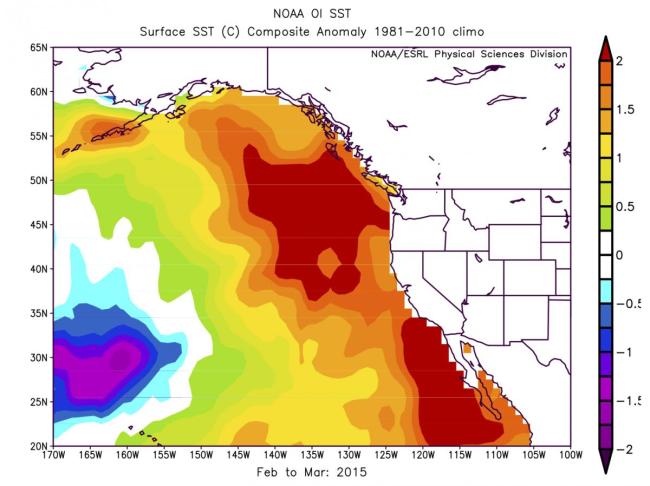Recent warming in the Northeast Pacific
Strongly positive sea surface temperature (SST) anomalies have prevailed in the Northeast Pacific Ocean since 2013. The causes and effects of these anomalies, sometimes referred to as the “blob”, are the results of a new paper in Geophysical Research Letters.

A persistent ridge of higher than normal sea level pressure was present over the Gulf of Alaska from October 2013 into February 2014. The anomalous air-sea interactions associated with this ridge resulted in reduced seasonal cooling of the upper ocean. The ridge itself, at least in part, appears to have been part of a large-scale remote response to conditions in the far western tropical Pacific. Warm SSTs in this region, and the enhanced deep convection, have been connected to a standing-wave pattern in the atmosphere from the tropics to higher latitudes in a manner similar to that associated with ENSO, but with roots farther west. This connection is indicated both in the observations and numerical model experiments.
The pattern of anomalous SST in the Northeast Pacific has evolved during the past year. These changes are due to transports associated with the mean ocean circulation and the weather, which during the winter of 2014-15 featured lower than normal sea level pressure over virtually the entire Northeast Pacific. As of spring 2015, a wide strip of relatively warm water is present along the entire West Coast of North America (Figure 1), in a pattern projecting on the positive phase of the Pacific Decadal Oscillation. These warm ocean temperatures have had major and wide-ranging impacts on the marine ecosystem. Furthermore, it will be interesting to see how the recent event unfolds in terms of both the physics and biology.
Causes and impacts of the 2014 warm anomaly in the NE Pacific (Geophysical Research Letters)
1University of Washington
2NOAA Pacific Marine Environmental Laboratory
3Institute of Ocean Sciences, British Columbia, Canada
4NOAA Southwest Fisheries Science Center
Topics
- Pacific Ocean
- Weather
- Ecosystem Impacts
